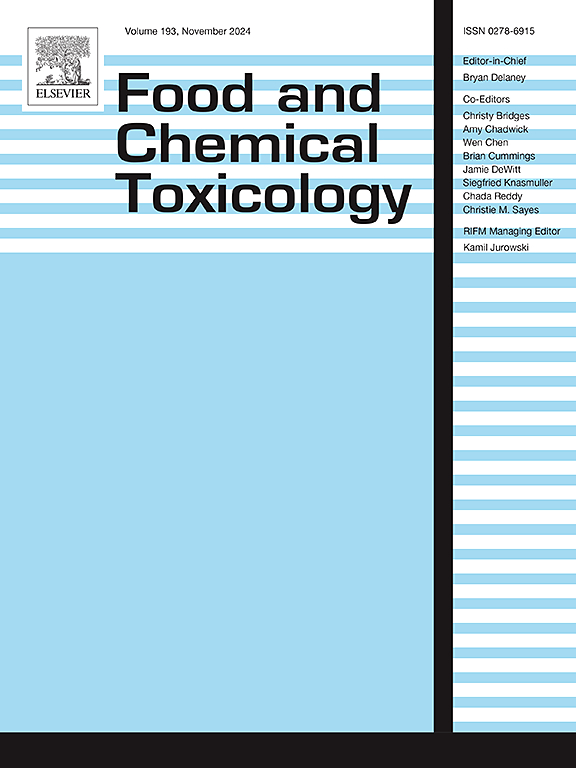The toxicological role of Myricetin in the progression of human anaplastic thyroid cancer SW1736 cell line
IF 3.5
3区 医学
Q2 FOOD SCIENCE & TECHNOLOGY
引用次数: 0
Abstract
Aims and background
Anaplastic thyroid cancer cells lack the capacity to effectively accumulate iodine and are therefore unresponsive to treatment with radioactive iodine. The main objective of this study was to examine the possible therapeutic effects of Myricetin on the SW1736 ATC cell line. In this study, we assessed the influence of Myricetin on iodide absorption, sodium iodide symporter gene expression, and apoptosis induction.
Material methods
The interaction between the 7UUY protein of NIS and Myricetin was investigated using AutoDock Vina. Assessment of cell viability was conducted with the MTT assay, whereas cell apoptosis was evaluated by flow cytometry using the Annexin V-FITC Apoptosis Detection kit. A spectrophotometric test based on the Sandell-Kolthoff reaction was conducted to assess the absorption of iodide by SW1736 cells. QRT-PCR analyses were used to assess the expression levels of NIS mRNA in SW1736 cells.
Results
The hydrogen bond interaction pattern created by PyMOL revealed the interactions between the target and ligand molecules. The results demonstrated that Myricetin-induced cell death is dependent on apoptosis in this type of thyroid cancer cell line. QRT-PCR analyses revealed significantly higher NIS mRNA (P < 0.001) levels in the Myricetin-treated group than in the non-treated group. Furthermore, Myricetin treatment significantly increased iodide uptake (P value = 0.0053) in the SW1736 thyroid cancer cell line compared to the control group.
Conclusion
These findings suggest that Myricetin has potential as a therapeutic agent by promoting growth inhibition, enhancing NIS gene expression, and increasing iodide uptake in SW1736 cells. Additional research is necessary to clarify the fundamental mechanisms and to evaluate the efficacy of Myricetin in preclinical and clinical settings.
三尖杉酯素在人类无性甲状腺癌 SW1736 细胞系进展过程中的毒理学作用
目的和背景:无性甲状腺癌细胞缺乏有效积累碘的能力,因此对放射性碘治疗无反应。本研究的主要目的是研究 Myricetin 对 SW1736 ATC 细胞系可能产生的治疗效果。在这项研究中,我们评估了杨梅素对碘化物吸收、碘化钠合体基因表达和细胞凋亡诱导的影响:使用 AutoDock Vina 研究了 NIS 的 7UUY 蛋白与 Myricetin 之间的相互作用。细胞活力的评估采用 MTT 法,细胞凋亡的评估采用 Annexin V-FITC 细胞凋亡检测试剂盒的流式细胞术。根据 Sandell-Kolthoff 反应进行了分光光度测试,以评估 SW1736 细胞对碘化物的吸收情况。QRT-PCR 分析用于评估 SW1736 细胞中 NIS mRNA 的表达水平:PyMOL创建的氢键相互作用模式揭示了目标分子和配体分子之间的相互作用。结果表明,在这种类型的甲状腺癌细胞系中,三尖杉酯素诱导的细胞死亡依赖于细胞凋亡。QRT-PCR 分析表明,NIS mRNA(PConclusion.PCR)明显升高:这些研究结果表明,通过促进生长抑制、提高NIS基因表达和增加SW1736细胞对碘的吸收,三尖杉酯素具有作为治疗药物的潜力。有必要开展更多的研究,以阐明其基本机制,并评估其在临床前和临床环境中的疗效。
本文章由计算机程序翻译,如有差异,请以英文原文为准。
求助全文
约1分钟内获得全文
求助全文
来源期刊

Food and Chemical Toxicology
工程技术-毒理学
CiteScore
10.90
自引率
4.70%
发文量
651
审稿时长
31 days
期刊介绍:
Food and Chemical Toxicology (FCT), an internationally renowned journal, that publishes original research articles and reviews on toxic effects, in animals and humans, of natural or synthetic chemicals occurring in the human environment with particular emphasis on food, drugs, and chemicals, including agricultural and industrial safety, and consumer product safety. Areas such as safety evaluation of novel foods and ingredients, biotechnologically-derived products, and nanomaterials are included in the scope of the journal. FCT also encourages submission of papers on inter-relationships between nutrition and toxicology and on in vitro techniques, particularly those fostering the 3 Rs.
The principal aim of the journal is to publish high impact, scholarly work and to serve as a multidisciplinary forum for research in toxicology. Papers submitted will be judged on the basis of scientific originality and contribution to the field, quality and subject matter. Studies should address at least one of the following:
-Adverse physiological/biochemical, or pathological changes induced by specific defined substances
-New techniques for assessing potential toxicity, including molecular biology
-Mechanisms underlying toxic phenomena
-Toxicological examinations of specific chemicals or consumer products, both those showing adverse effects and those demonstrating safety, that meet current standards of scientific acceptability.
Authors must clearly and briefly identify what novel toxic effect (s) or toxic mechanism (s) of the chemical are being reported and what their significance is in the abstract. Furthermore, sufficient doses should be included in order to provide information on NOAEL/LOAEL values.
 求助内容:
求助内容: 应助结果提醒方式:
应助结果提醒方式:


